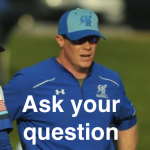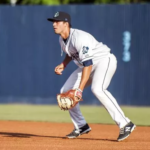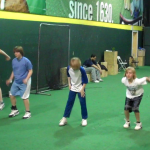Scoring Runs Without Hitting Part I
Many times, you will hear coaches and players mistakenly refer to offense strictly as "hitting." They will say things such as "we just didn't hit today," or "we could not hit that pitcher." There is no doubt that on a day when you don't score many runs, those statements are true, however this rationale shows an imperfect understanding of how runs are scored. Coaches and players need to realize that some days, you will not be able to “hit” the pitcher. On days like these, you need to be able to score runs without hitting. This four part series will look at the various ways to generate offense without hitting.
Part I: Getting on base
There are seven different ways a batter can reach base safely. Two of the seven, are largely out of the control of the hitter (catcher’s interference, drop third strike), and one of them (fielder’s choice) requires that someone already be on base and gives no real offensive advantage. Other than getting a hit, there are three ways to get on base that offense has control over: walk, hit by pitch, or reaching base due to an error. Let’s examine each of those three carefully to determine how your players can give themselves the best chance to get on base without getting a hit.
Hit by pitch:
Watch a high school or college game and you will hear screams of “wear it!” or “we got ice!” coming from the offensive teams dugout anytime a player jumps out of the way of a pitch. Whether you teach your kids to stand in the box and take a pitch off their body or not is an ethical dilemma that each coach and player will have to sort out. Usually there is little negative side effect from getting hit by a pitch other than a bruise, however it is undeniable that getting hit by a baseball poses some risk for injury, and puts a player’s safety at risk.
There is one area where most coaches and players will agree, and that is hanging in on breaking balls. When a hitter sees a breaking ball inside, they need to hold their ground. Sometimes the ball will take the break, and end up in the strike zone, other times it won’t and will end up inside, and may hit the batter. Either way, holding in the box is a winning strategy, you increase the possibility of hitting a breaking ball, and you increase the chances of getting on base via a hit by pitch.
Sign up for CCA's free content here
Reaching on an error:
It may not be apparent how the offensive team can affect the defense’s ability to make a play. There are two basic ways the offense can impact the defense’s ability to make plays. The first is by hitting the ball hard, but remember this is a day when we are not hitting well, so hitting the ball hard may not happen very often. The second is simply to hustle out of the box on every single ball put in play. The more pressure you put on the opposing defense by hustling out of the box, even if you are not that fast, will increase the chances they make an error by trying to hurry a throw.
As a coach, you have the ability increase your players’ willingness to hustle in several ways, many of them depend on your individual coaching style and may vary from coach to coach. One proven method is to point out to the whole team examples of players whose hustle causes opponents errors. I have found that positive reinforcement is a great tool for molding behavior.
Taking walks:
It is a misconception that a walk is only the result of a wild pitcher. It is no coincidence that the same players are at or near the top of MLB in walks year after year after year. One of the keys to taking walks on a regular basis is having a patient approach at the plate. This approach is not one that actively seeks walks. This approach has one simple goal, getting a good pitch to hit. This approach requires your players to do three things. First, your players must be patient. Second, they must not swing at pitches early in the count just because they are strikes and thirdly, players cannot be afraid to hit with a two strike count.
Other than producing more walks by being patient, waiting for your pitch and working counts deep, you are also running up the pitcher’s pitch count. On a day when you are not able to generate offense by hitting, the pitcher is unlikely to have to pitch in many tough situations and is unlikely to throw a lot of pitches. Since he is obviously difficult to hit, you would like to get him out of the game. It is possible through being patient to run up a starting pitcher’s pitch count that he will need to be removed from the game.
Summary:
Days when you cannot hit can be very frustrating for coaches and hitters alike, but rest assured, there are many things that are in your control that your team can do to get runners on base. As you know, getting runners on base is only one part of the run scoring equation. In the next installments we will be looking at ways to move runners over (part 2), ways to get runners in (part 3) and the mental side of offense when you aren’t hitting (part 4).
More from my site
 Mini – Make your batting practice better
Mini – Make your batting practice better Mini – What have I been up to – November 22nd
Mini – What have I been up to – November 22nd CCA Podcast 116: Components of a great infielder
CCA Podcast 116: Components of a great infielder Baseball Conditioning: Without a Weight Room
Baseball Conditioning: Without a Weight Room CCA Podcast 195 – What to do AFTER you run your hitting assessment
CCA Podcast 195 – What to do AFTER you run your hitting assessment CCA Podcast 131 – Small things that make a big difference part 2
CCA Podcast 131 – Small things that make a big difference part 2
 Posted by Kyle Nelson
Posted by Kyle Nelson- Posted in Uncategorized
 Dec, 19, 2012
Dec, 19, 2012 1 Comment.
1 Comment.
Elite members login here
Check out what’s New/Hot!
Recognizing, Diagnosing, and Fixing Common Hitting Flaws eCourse The 3 metrics we tested on Blast motion sensors this year Sneak Peek Inside an Elite Q and A The batting practice continuum Elite Member’s area table of contents 50+ “Chaos” hitting drills
5 sample Chaos hitting drills FREE
Mental Skills and Culture Building The hitting pyramid Welcome Elite Member, Trey! Ideas for a pitcher first practice 12 week bat speed improvement plan Make plans this offseason to have your team playing their best baseball at the end of the year” Top 5 hitting drills to translate practice skill to game performanceHow we used Blast Motion sensors with a team in 2019
What to do if your hitters are overmatched Welcome Elite Member, Tommy! Setting your baserunners up for success Welcome Elite Member, Mike! A consulting call with Elite Member Matt FREE Web Clinic: Developing Athletic, Consistent, Extraordinary Infielders
 Coach Kyle Nelson
Coach Kyle Nelson
THIS IS GOOD. WELL THOUGHT OUT.
LOOKING FOR TALENT FOR FALL AND WINTER BASEBALL!!